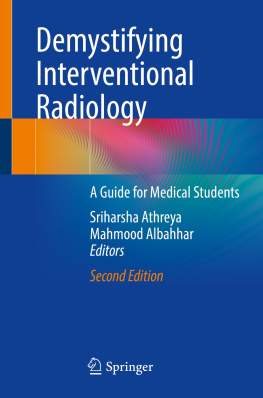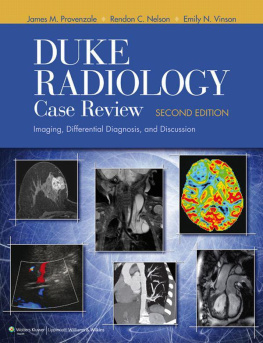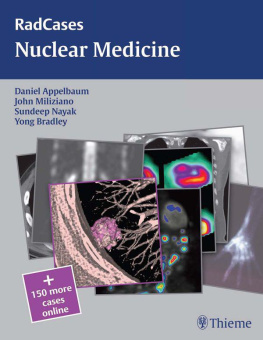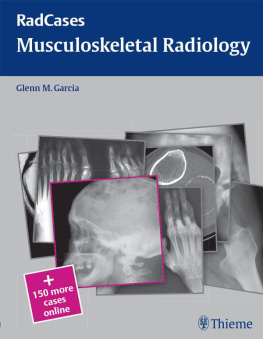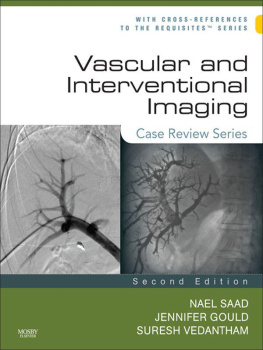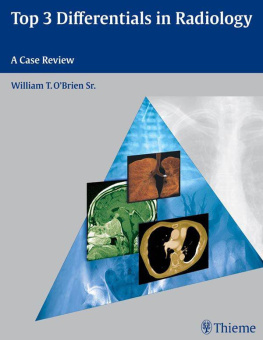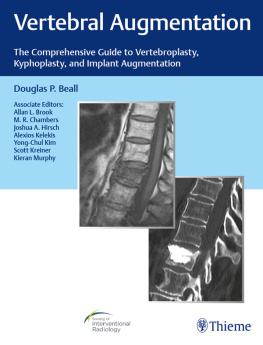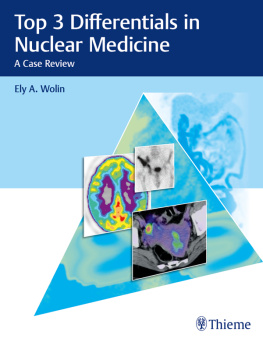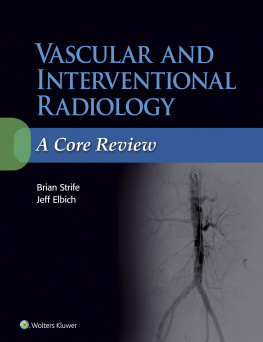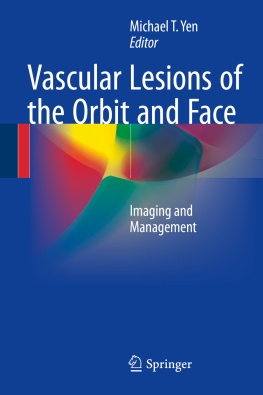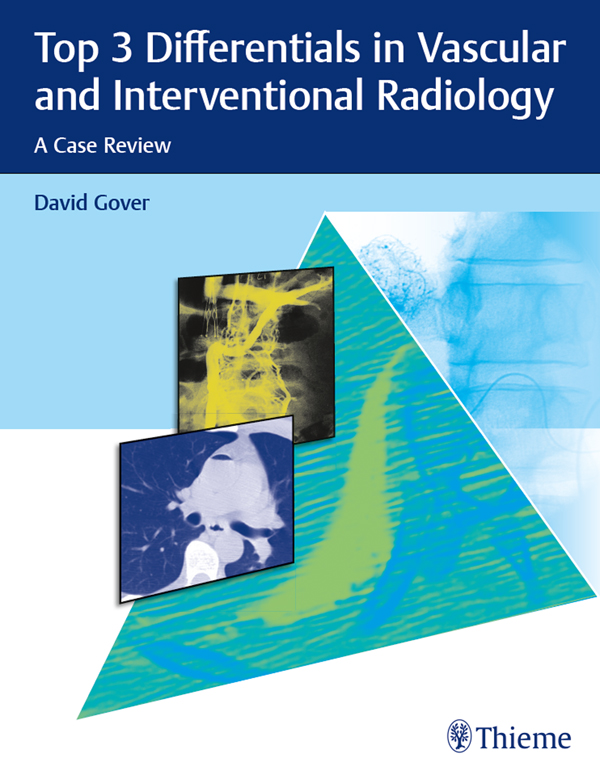Top 3 Differentials in Vascular and Interventional Radiology
A Case Review
David D. Gover, MD
Chief
Vascular & Interventional Radiology
David Grant USAF Medical Center
Travis Air Force Base
Associate Clinical Professor
Volunteer Faculty Series
University of California
Davis, California
Series Editor:
William T. OBrien, Sr., DO, FAOCR
Director, Pediatric Neuroradiology Fellowship
Cincinnati Children's Hospital Medical Center
Associate Professor of Radiology
University of Cincinnati College of Medicine
Cincinnati, Ohio
425 illustrations
Thieme
New York Stuttgart Delhi Rio de Janeiro
Executive Editor: William Lamsback
Managing Editor: Apoorva Goel
Director, Editorial Services: Mary Jo Casey
Production Editor: Shivika
International Production Director: Andreas Schabert Editorial Director: Sue Hodgson
International Marketing Director: Fiona Henderson International Sales Director: Louisa Turrell
Senior Vice President and Chief Operating Officer: Sarah Vanderbilt
President: Brian D. Scanlan
Library of Congress Cataloging-in-Publication Data is available from the publisher.
2019 Thieme Medical Publishers, Inc.
Thieme Publishers New York
333 Seventh Avenue, New York, NY 10001 USA
+1 800 782 3488,
Thieme Publishers Stuttgart
Rdigerstrasse 14, 70469 Stuttgart, Germany
+49 [0]711 8931 421,
Thieme Publishers Delhi
A-12, Second Floor, Sector-2, Noida-201301
Uttar Pradesh, India
+91 120 45 566 00,
Thieme Publishers Rio de Janeiro,
Thieme Publicaes Ltda.
Edifcio Rodolpho de Paoli, 25 andar
Av. Nilo Peanha, 50 Sala 2508
Rio de Janeiro 20020-906 Brasil
+55 21 3172 2297
Cover design: Thieme Publishing Group
Typesetting by DiTech Process Solutions, India
Printed in USA by King Printing Company, Inc. 5 4 3 2 1
ISBN: 978-1-62623-356-0
Also available as an e-book:
eISBN: 978-1-62623-357-7
Important note: Medicine is an ever-changing science undergoing continual development. Research and clinical experience are continually expanding our knowledge, in particular our knowledge of proper treatment and drug therapy. Insofar as this book mentions any dosage or application, readers may rest assured that the authors, editors, and publishers have made every effort to ensure that such references are in accordance with the state of knowledge at the time of production of the book.
Nevertheless, this does not involve, imply, or express any guarantee or responsibility on the part of the publishers in respect to any dosage instructions and forms of applications stated in the book. Every user is requested to examine carefully the manufacturers leaflets accompanying each drug and to check, if necessary in consultation with a physician or specialist, whether the dosage schedules mentioned therein or the contraindications stated by the manufacturers differ from the statements made in the present book. Such examination is particularly important with drugs that are either rarely used or have been newly released on the market. Every dosage schedule or every form of application used is entirely at the users own risk and responsibility. The authors and publishers request every user to report to the publishers any discrepancies or inaccuracies noticed. If errors in this work are found after publication, errata will be posted at www.thieme.com on the product description page.
Some of the product names, patents, and registered designs referred to in this book are in fact registered trademarks or proprietary names even though specific reference to this fact is not always made in the text. Therefore, the appearance of a name without designation as proprietary is not to be construed as a representation by the publisher that it is in the public domain.
This book, including all parts thereof, is legally protected by copyright. Any use, exploitation, or commercialization outside the narrow limits set by copyright legislation, without the publishers consent, is illegal and liable to prosecution. This applies in particular to photostat reproduction, copying, mimeographing, preparation of microfilms, and electronic data processing and storage.
To My Eternal Sweetheart,
Shannon,
and our Top 3:
Brighton, Darby, and Reese.
These are the truest pearls!
Contents
William T. O'Brien, Sr.
Series Foreword
The original Top 3 concept was something engrained in us during our residency training in the military. From day 1, our program emphasized the importance of having gamut-based differentials as part of our daily readout sessions, as well as during didactic and clinical case-based conferences. The bulk of residency training was then centered around learning the key clinical and imaging manifestations of each entity on the list of differentials to be able to distinguish one from another, when possible. To avoid providing clinicians with a laundry list of differentials that would be of little value, we were encouraged to consider the Top 3 differentials and any other important considerations based on the specific clinical scenario or imaging finding(s) presented. I found this concept and approach to radiology so useful that I continue to utilize it to this day.
One thing I learned throughout my radiology career, especially as a residency program director, is that not every individual learns or processes information in the same manner. Some individuals can read through a traditional textbook that is organized by pathology (i.e., developmental abnormalities, infectious processes, neoplasms, etc.) and readily recognize that the developmental abnormality in Chapter 1 is in the same differential for the infectious process in Chapter 2 and a few neoplasms in Chapter 3. Others, like me, best learn from gamut-based resources where content is organized based on the key imaging findings, similar to how we practice radiology. If you are part of the latter group, then the Top 3 approach may be the right fit for you. The intent of the series is to provide a comprehensive case-based alternative to traditional subspecialty textbooks where the focus remains on differential diagnoses. After all, when the dust settles and the core and certifying exams are nothing but distant (and hopefully pleasant) memories, this is what radiology is all about.
Vascular and Interventional Radiology (VIR) was one of the challenging subspecialties to incorporate into the Top 3 format, since VIR is often more focused on management and diagnostic or therapeutic approaches than on differential diagnoses. I was initially hesitant to include VIR as a subspecialty edition in this series until I broached the topic with Dr. David Gover. He had the idea of organizing the book in a similar manner as he approaches the field of VIRinitial patient work-up, differentials for imaging findings, cases where the diagnosis is known (Aunt Minnies), pertinent anatomy, and postprocedural management. The end result is an exceptionally creative adaptation of the Top 3 format to fit the practice of VIR, with clinical and management pearls presented throughout.
It is my sincere hope that you will find this unique approach to VIR both enjoyable and educational.
William T. OBrien, Sr., DO, FAOCR
Preface
The purpose of this book is to provide a framework for the student of interventional radiology (IR). This project began as I was preparing for my board recertification examination and morphed into something larger at the encouragement of the publisher. By no means is this an exhaustive work. I am well aware that there are many more qualified practitioners, who might author more comprehensive textbooks, but I believe that this compilation will help create an organized approach to many common IR situations via a case review format. My hope is that this work will be helpful to the medical student contemplating a career in IR, to residents in preparation for rotations or examinations, and to practicing radiologists who wish to hone their skills.


